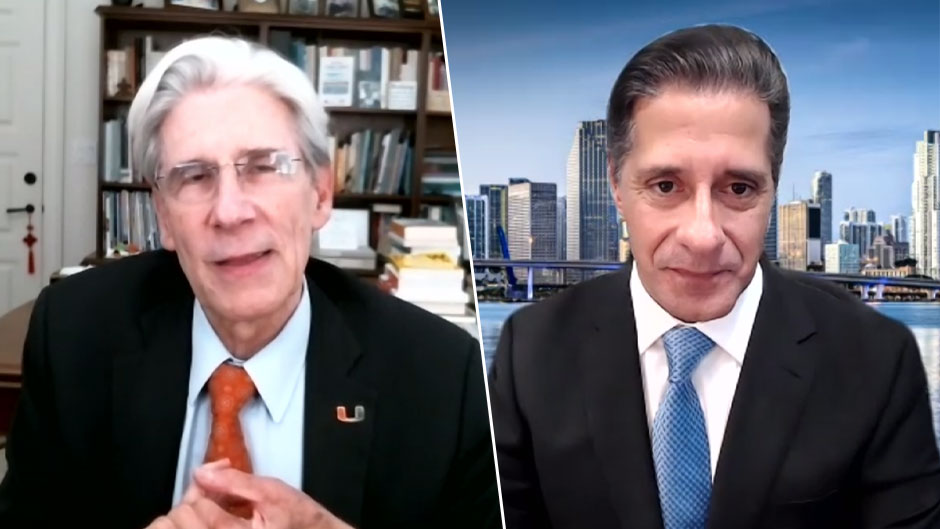University of Miami President Julio Frenk and Miami-Dade County Public Schools Superintendent Alberto Carvalho shared some lessons they learned from leading a swift transition to remote learning last spring—as well as their plans for navigating the rest of the school year during a global pandemic—at a Miami-Dade Gay and Lesbian Chamber of Commerce webinar on Wednesday.
Both the University and the school system are closely monitoring the county’s COVID-19 statistics, which recently showed a downward trend in positivity rates. These are hovering around 5 percent throughout the past two weeks, according to the Florida Department of Health.
While the University of Miami started its semester in person, with many safeguards in place and some students opting to attend remotely or through a hybrid approach that combines in-person and remote learning, Miami-Dade’s more than 300,000, K-12 public school students began the year by meeting their teachers through a computer screen. Despite the massive technological progress both institutions have made since March, the leaders were hopeful that a return to in-person classroom instruction can occur for all students in the near future.
“The pandemic has created a craving for interpersonal communication. So, as we faced the choice of what to do in the fall, we decided to give a choice to our students. And interestingly, three-quarters of them opted to come to campus,” said Frenk. “Even with restrictions, such as masks required indoors and outdoors and a host of new technology required for teaching with physical distancing, we have been able to reopen.”
Still, making that happen was no easy task. Students at the University faced several obligations to attend in-person classes this fall, including taking a COVID-19 test before heading to campus. In addition, Frenk—a global health expert who led Harvard’s T.H. Chan School of Public Health and served as a minister of health in Mexico—spent the summer working with faculty and staff to develop a safe return to campus plan in which the University has invested millions of dollars.
And, Frenk shared that in the past month, data has shown that University of Miami students who have tested positive for COVID-19 are far more likely to contract the virus in social settings off campus, according to the University’s vigorous testing and contact tracing program. The same holds true for faculty and staff.
“So far, things are moving in the right direction, although we can never let our guard down,” Frenk added.
While technological snags marred the start of the county’s remote school year, Carvalho is meeting with a team of medical experts this week to get advice about physically reopening. And he said an announcement could be made by Monday about when Miami-Dade students might return to schools. He pointed out that students would go back in phases—starting with the county’s most fragile learners, then followed by its youngest students.
“We are looking forward to welcoming students back to the schoolhouse,” Carvalho said. “There is no comparable, equitable, or equal place for a child, particularly a young child, than a nurturing, organic space where teaching and learning can take place. This issue of socialization is so important, particularly for younger students, but also as a societal protection against the ills that can in fact impact kids.”
Both institutions heavily invested in technology ahead of the pandemic, and Carvalho and Frenk said they were grateful for that foresight because it allowed a relatively smooth transition to distance learning last spring. Now, Frenk said, University faculty members are well-versed in online tools, and classes will likely always have the option of a remote component.
“At the U, we have invested in technology for some time. So, this has allowed us to put it to the test,” he said, adding that the University is the first in the nation to enable 5G technology as a result of its partnership with AT&T. “And our experience over the past six months has cemented our commitment to a blended model of education that facilitates life-long learning.”
According to Carvalho, technology also played a key part in the county’s ability to pivot to remote learning last March.This was possible because the school system issued a bond that was passed by voters in 2012 that provided $1.2 billion for infrastructure. This allowed the district to purchase a large amount of technology equipment for the county’s students that helped facilitate remote learning. It also distributed more than 120,000 laptops and many wireless hotspots to students in need last spring.
Still, he said, there is no substitute for face-to-face contact with teachers, particularly to help the region’s most vulnerable students reach key learning goals.
“Last spring our attendance average was over 91 percent. But I’m not going to lie to you, while attendance is one thing, engagement is a very different thing. And we know for a fact that some of our most fragile students have regressed,” he said. “English-language learners, students in poverty, and students with disabilities really struggled with distance-learning protocols, but we made it through. Now, we’re looking forward to a good school year as never before, regardless of the impossible nature of the challenge before us. We have the determination and will to do it right.”

